Employee Engagement - Insights for 2023
Many organisations struggle to see tangible success from their employee engagement activities. Discover how you can boost staff involvement and reap the benefits of a happier, more productive workforce.
Many organisations struggle to see tangible success from their employee engagement activities. Discover how you can boost staff involvement and reap the benefits of a happier, more productive workforce.
Employee engagement is essential to your business. In fact, the importance of an effective employee engagement strategy can’t be overstated. A strong strategy will ensure your employees are happier and more motivated in their work, leading to reduced staff turnover, greater customer retention and improved productivity. It will infuse your working environment with purpose and enthusiasm. And, ultimately, your employees and your business will thrive.
When you have an environment where employees are engaged by their work, you’ll benefit from:
With the right knowledge, the right tools, and most importantly, an employee-focused mindset, it can be a powerful way to transform your organisation.
This guide will help you get the very best from your employees - every single one of them. We cover a comprehensive range of employee engagement improvement ideas and initiatives to put your strategy right on track.
Defining employee engagement can be a bit of a minefield. Every organisation is different, with different aims, values and challenges and therefore will ultimately need its own personalised definition of employee engagement. However, for an overall perspective, we like David MacLeod’s definition:
(Employee engagement) is about how we create the conditions in which employees offer more of their capability and potential.
David MacLeod1
This definition is powerful because it puts the onus on the employer to create the right environment, not the employee to do all the legwork. A focus on the responsibilities of the employer means that they must assume the tasks of promoting, creating, and sustaining engagement, not just instigating it.
In order to apply this principle to your business, you’ll need to address these eight fundamental components:
The impact of leadership on employee engagement can’t be overstated. Not only must leaders promote best practice, their actions can have a profound impact on employee engagement. Employees want meaningful relationships with their line managers and leaders. According to a McKinsey Quarterly survey [2], praise from an immediate manager is considered a more effective motivator than a pay rise.
Business leaders need to drive engagement as part of their company’s culture, because the single greatest predictor of employee commitment is their relationships with their managers. And, remember, praise doesn’t cost a thing.
Senior management also needs to drive employee engagement from the top down. A grass-roots engagement scheme that relies on employees to initiate has been proven to be ineffective; successful employee engagement comes from the senior management team. Implementing employee engagement initiatives ideas should be at the top of a leader's to-do list.
Engaged employees understand the big picture and how they fit into it. If you’re wondering how to create a sense of belonging, you’ll find that a clearly communicated vision and statement of core values gives employees a flag to rally around.
When staff feel a part of something bigger, they have an emotional stake in the success. This makes it more likely that they will remain committed and driven to deliver results.
Alongside values comes social responsibility. Successful companies tend to be deeply connected with their communities, committed to social outreach, and they encourage employees to participate in worthy causes.
This has a powerful effect on employee engagement. Employees who are proud of the community contributions their organisation makes are twice as engaged as those that aren’t.
Company culture is a phrase most commonly associated with employee engagement. That’s because culture defines the emotional environment of your workplace.
A positive corporate culture means happy employees who want to come to work every morning. On the other hand, a negative culture leads to disenfranchisement and unproductive staff.
How you communicate internal messages is just as important as what you’re saying. Good communication means that everyone in your organisation, even hard to reach employees, are getting the same experience. When it comes to keeping remote workers engaged, flexible and effective communication channels are key.
More so, giving your employees the power to communicate back to you is a vital component of employee engagement. You need to provide staff with the tools they need to engage effectively.
The implementation of an employee recognition scheme will have a highly beneficial effect on organisational culture and engagement. If you’re struggling with employees not feeling engaged at work, addressing the issue of recognition can have a big impact.
A well-defined reward system allows you to effectively differentiate between employee activity and tie benefits directly to the behaviour that matters most to your organisation. What gets recognised gets repeated, so you’re able to affect the behaviours of your employees in a way that is beneficial to everyone.
The opportunity to develop new skills is important to ambitious employees. Your ability to provide access to training and development will have an impact on how connected employees feel with their work and your business.
We all like to win. Staff who perform well feel good about themselves, and where they work. People also feel more engaged when they can see the result of their work and how that fits into the bigger picture.
To improve performance, senior management needs to provide honest feedback. Immediate praise reinforces desired behaviours, and timely criticism can help avert future problems.
Employee engagement is important because it can affect your bottom line. Disengaged employees cost the economy over £50 billion a year in lost productivity, according to a survey by CBBenefits [3].
Personnel who lack engagement make 100 times more errors than their engaged colleagues and spend less time working; they chat, take more breaks, procrastinate, surf the internet etc.
What’s worse, the negativity of disengaged staff rubs off on the people around them, turning potentially engaged employees into non-engaged workers.
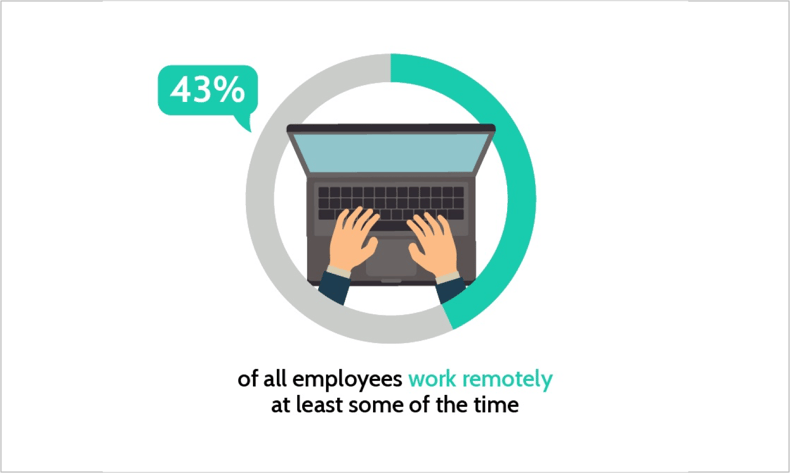
Source: Queens University - Communicating in the workplace
Keeping everyone informed and involved is easier said than done. Common barriers include the fact that not every business has…
Furthermore, newer barriers are appearing. Almost half of all employees now work remotely at least some of the time. Flexible working, changing employee expectations, and new technology are presenting new challenges to internal communications. These developments need to kept in mind when ideas for employee engagement programmes are being established.
Maintaining control of your vision and message is another major challenge for businesses. The “always-on” technology landscape means that information about your business is now available for all your employees to see – before the monthly newsletter is a twinkle in its creator’s eye.
But, it’s not all bad news, because these challenges also present opportunities. New ways of working and new technology help alleviate traditional problems such as incomplete cascades and the reliance on Line Managers to correctly interpret information. In fact, opportunities to improve employee engagement with technology are now abounding. The arrival of Employee Engagement Apps and Internal Communication Platforms are providing new, flexible channels to reach your employees, in ways that really resonate with them.
When it comes to employee engagement, there’s no single approach that will work for every business. There’s no one-size-fits-all solution. That’s because every business is unique, with its own brand, culture, structure and mix of employees. However, there are many proven strategies that will get results and make a noticeable difference to your organisation.
We have included some of the very best employee engagement ideas. Pick the ones that best suit your business and work them together to improve employee engagement to retain your workforce.
Why? A defined employee engagement strategy is the blueprint guiding you to success
Start as you mean to go on. With a detailed outline that defines your business goals in communicating with staff and plans the activities required to achieve these goals.
What is employee engagement, as applies to your business? Do you need your staff to be able to adapt to upcoming change? Or maybe you need your employees to work better together as a team? Every organisation has different challenges to face and this will affect the strategy you decide on.
Once you have your plan, it will be need to be executed. Make sure you have all the resources in place. Then pack your plan with creative employee engagement ideas to get your staff fired up with energy and enthusiasm.
Why? When all employees feel aligned, it leads to a sense of engagement
So often, that “information is power” attitude manifests itself as a reluctance to share and interact. Suddenly silos are popping up all over the place. According to a Queens University study [4], 39% of employees are feeling the impact of a lack of collaboration.
This becomes more prevalent the larger your organisation becomes. If you open a new office or start franchising out your brand, it becomes harder to maintain business alignment.
The key to effective employee engagement is to ensure that everyone knows what the right direction is (the goal) and what their part is in getting there (their role). Everyone needs a view of the bigger picture.
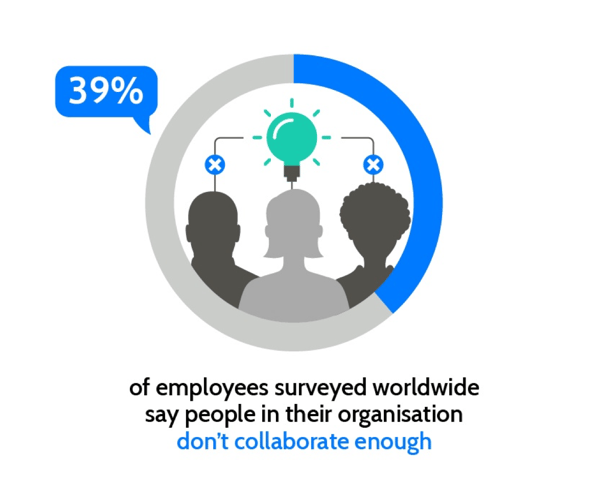
Source: Queens University - Communicating in the workplace
Why? A steady flow of information helps to connect directors with those at the coalface
The best employee engagement improvement ideas always start with information. You need to create free flowing channels of information to share the strategic direction and company vision.
Directors make decisions on how to run a company daily and employees are the ones who live and breathe the impact of these decisions. Without understanding the what and the why, employees risk not feeling engaged at work.
An employee app is an ideal way to centralise communications. Instead of using disparate channels from a number of sources, you can keep the news relevant and on brand, and essentially, easy to access from one central hub.
Why? Engagement starts with a feeling of inclusion. Listening shows you care.
Implement an employee listening strategy by allowing your employees to voice their opinions. It’s a great way to check the pulse of what matters at the coalface of your business. However, it’s a sad truth that only 30% of staff feel like their voices are heard [5].
In this age of social media, people now expect to be able to engage in a two-way conversation. This presents an interesting challenge for internal communicators, especially given that many organisations haven’t yet adopted this type of channel internally.
Fortunately, an Employee Engagement App will have these two-way channels built in, easily facilitating the flow of feedback. By opening up channels for discussion – in the right forum and on the right topics – you can go a long way towards improving employee engagement and creating a collaborative workplace.
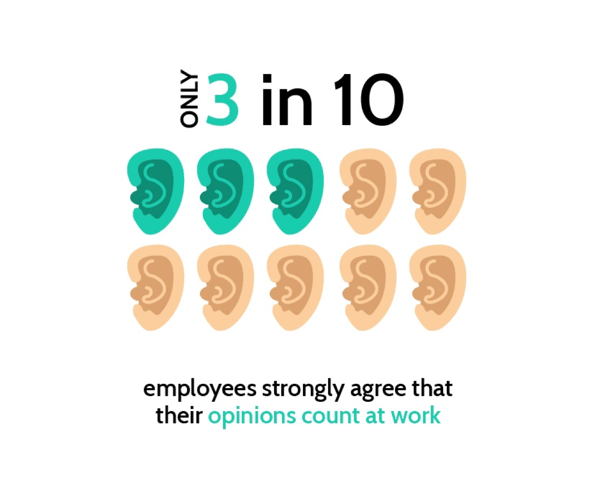
Source: Gallup 2017 - How to Create a Culture of Psychological Safety
Why? Employees need to know you are offering an unbiased source of information
Trust needs to come from all levels of the organisation. Leaders need to trust Internal Communications to get things right; to understand when a business can and can’t be open and honest. And employees need to trust Internal Communications to be an unbiased source of information and a conduit for their feedback.
Consider providing stakeholder management training. More so than in other roles, the internal communications team may have to discuss or offer a counter opinion to senior leaders. They need to understand how to do this tactfully and respectfully.
That way, internal communications teams can create effective forums for employee engagement, based on truth and business strategy.
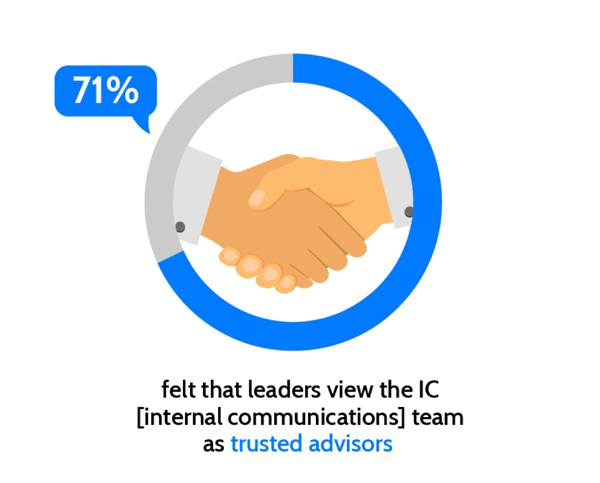
Source: Gatehouse - State of the Sector 2018
Why? Employee engagement strategies need to demonstrate a return on investment
When it comes to ideas for employee engagement programmes, finding a way to show an impact on the bottom line should always be on your list.
This can be a major challenge for something as conceptual as employee engagement. A lack of clear objectives within the organisation creates a grey area that is at risk of being filled with well-intentioned, but ineffective, activity. The fact that 60% of communicators don’t measure the effectiveness of their activity [6] demonstrates the low priority this is often given.
Determining deliverables is the first step to building a strategic mindset. When it comes to employee engagement, deliverables include everything from feedback and recognition to internal relationships and happiness levels. Don’t forget to measure personal growth and job satisfaction, key components to high engagement levels.
A clear, measurable business strategy should be easy to interpret at all levels of the organisation.
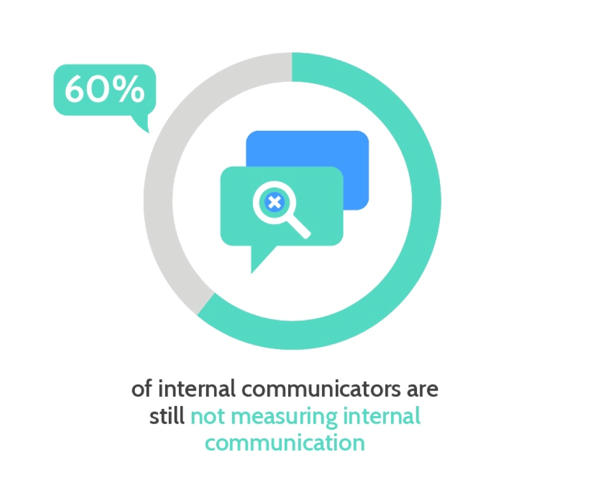
Source: Veronika Mazour - How to measure your internal communications’ effectiveness?
Why? Measuring employee engagement should never be a one-time event
Once you have your deliverables in place and you’ve set up monitoring actions, keep going. Whether your deliverables are briefings, channel management, or surveys, you should automate processes where possible to help streamline the department. Employee engagement ROI should be a vital part of your business objectives.
In addition, whenever you launch new employee engagement ideas, it’s essential to get feedback to see if they have worked. You may find that they did, or you may find that they didn’t go far enough. Your plan may improve engagement in one department or section but uncover issues in another.
So, in addition to regularly surveying employees, set up a dashboard to track vital success metrics. Make it easy for yourself - an employee engagement platform will have these dashboards built in and ready to use.
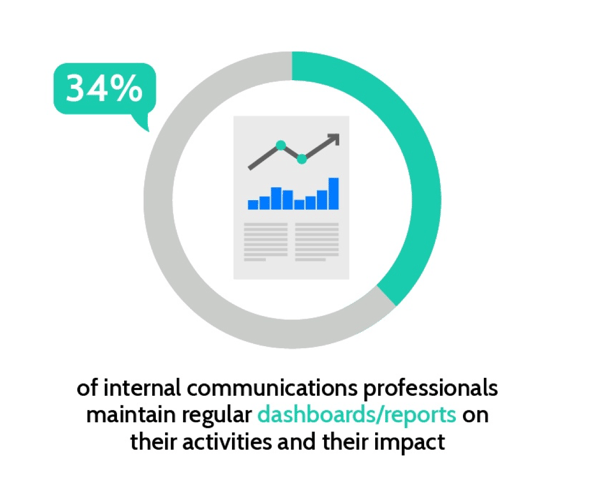
Source: Gatehouse - The definitive survey of the Employee Engagement and Internal Communication landscape 2018
Why? A genuinely engaged employee is always the best ambassador for your brand
Brands are increasingly turning to their employees as advocates of their products and services. Nurturing brand advocates internally gives your messaging an engaging, peer-to-peer channel. So, as well as being a measurement of engagement, employee advocacy can become the catalyst for greater engagement throughout your organisation.
Employee engagement survey results show that 50% of employees already post messages, pictures or videos about their employer on social media [7]. It makes sense to harness this power, rather than trying to silence it.
These social media stories are then available to the wider external audience and provide share-worthy material. This helps build strong internal relationships, breaks down silos, and encourages more meaningful interaction.
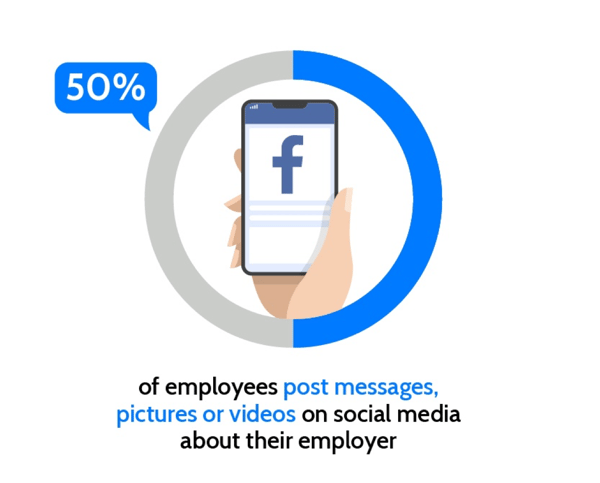
Source: Weber Shandwick - Employee Activism: The next frontier of employee engagement
Why? A buddy scheme will improve retention of new employees and lift engagement levels
Whether you decide on a casual buddy scheme or more formal mentoring programme, this simple staff engagement idea can have a dramatic effect. For new hires in particular, having someone to turn to in those first few weeks can make all the difference between an employee who settles in smoothly and an employee who walks.
Employees who have a best friend at work are seven times more likely to be engaged in their role. Simply by encouraging friendships and connections, you will find that knowledge is shared more freely, collaboration is enhanced and enthusiasm levels rise.
Of all the initiatives to improve employee engagement, this one is the most flexible. There are multiple ways to implement such a scheme, from face to face chats to app-based chatting. Explore which works best for your business.
Why? Incentives need to be clear and defined in order to have the maximum benefit
Give them a bonus and they’ll be happy. Yes? Well, actually no. If you indiscriminately reward staff without linking it to progress and success, you could end up damaging engagement levels.
Employee engagement ideas based on bonuses and rewards need to be handled with caution. Rewards without reason can make staff complacent and under-productive.
Instead, use rewards for jobs well done and progress made. When delivering incentives, make sure it is clear why employees are being rewarded. This way they’ll know how to keep delivering in line with expectations, which will then boost job satisfaction. If you’re wondering how to implement employee engagement, this is an excellent tool to consider.
In the same way you keep tract of finances and sale targets, you also need to keep a close eye on how your employee engagement strategy is performing. Regular monitoring of employee engagement ROI is an essential element of any strategy.
There are two ways to measure employee engagement. The first is to reach out with surveys and one-to-one meetings with employees (1-2-1s). Using the data collected, you can apply values to your deliverables and turn something as nebulous as sentiment into a mathematic variable. The second is to take a more holistic approach to the question and look at outcomes rather than statistics.
Surveys
Short, frequent surveys are a fast way to get the pulse on the vibe in your organisation. The trick is to keep it simple. Ask anywhere from 5-10 questions about how people are feeling at work and what (if anything) they would change.
Completion rates are important when it comes to employee surveys. The rate will vary by the size of your business, as seen below:
|
Company Size |
Expected Survey Participation Rate |
|
<50 |
80-90% |
|
500+ |
70-80% |
|
1,000+ |
65-80% |
One way to get 100% participation is to schedule 1-2-1s with every member of staff. This approach has many advantages but can take more time.
The key advantage of 1-2-1s is collecting feedback in person. Because it’s a private, safe conversation, you can get qualitative detail about each issue that’s brought up. But be aware, having regularly scheduled, hour-long meetings with each member of your team can quickly become too time-intensive
Alternatively, you could choose a holistic approach to measuring employee engagement. Instead of measuring satisfaction and happiness, a holistic approach considers the outcomes that employee engagement produces. These might include productive output, fewer sick days, more shares on business social media posts.
An effective, cloud-based employee engagement platform provides both the tools and the environment for employee engagement to benefit your entire organisation. It allows your employees to be effective and more successful. This approach turns employee engagement from a “touchy-feely” HR issue, into a channel tied to specific business outcomes.
Talkfreely can help you create an environment where employee engagement doesn’t just improve, but really matter to your organisation.
[1] MacLeod, D. and Clarke, N. - Engaging for Success
[2] McKinsey Quarterly - Motivating people
[3] CBBenefits – The cost of disengaged employees
[4] Queens University of Charlotte – Communicating in the Workplace
[5] Gallup 2017 - How to Create a Culture of Psychological Safety
[6] Veronika Mazour - How to measure your internal communications’ effectiveness?
[7] Weber Shandwick - Employee Activism: The next frontier of employee engagement